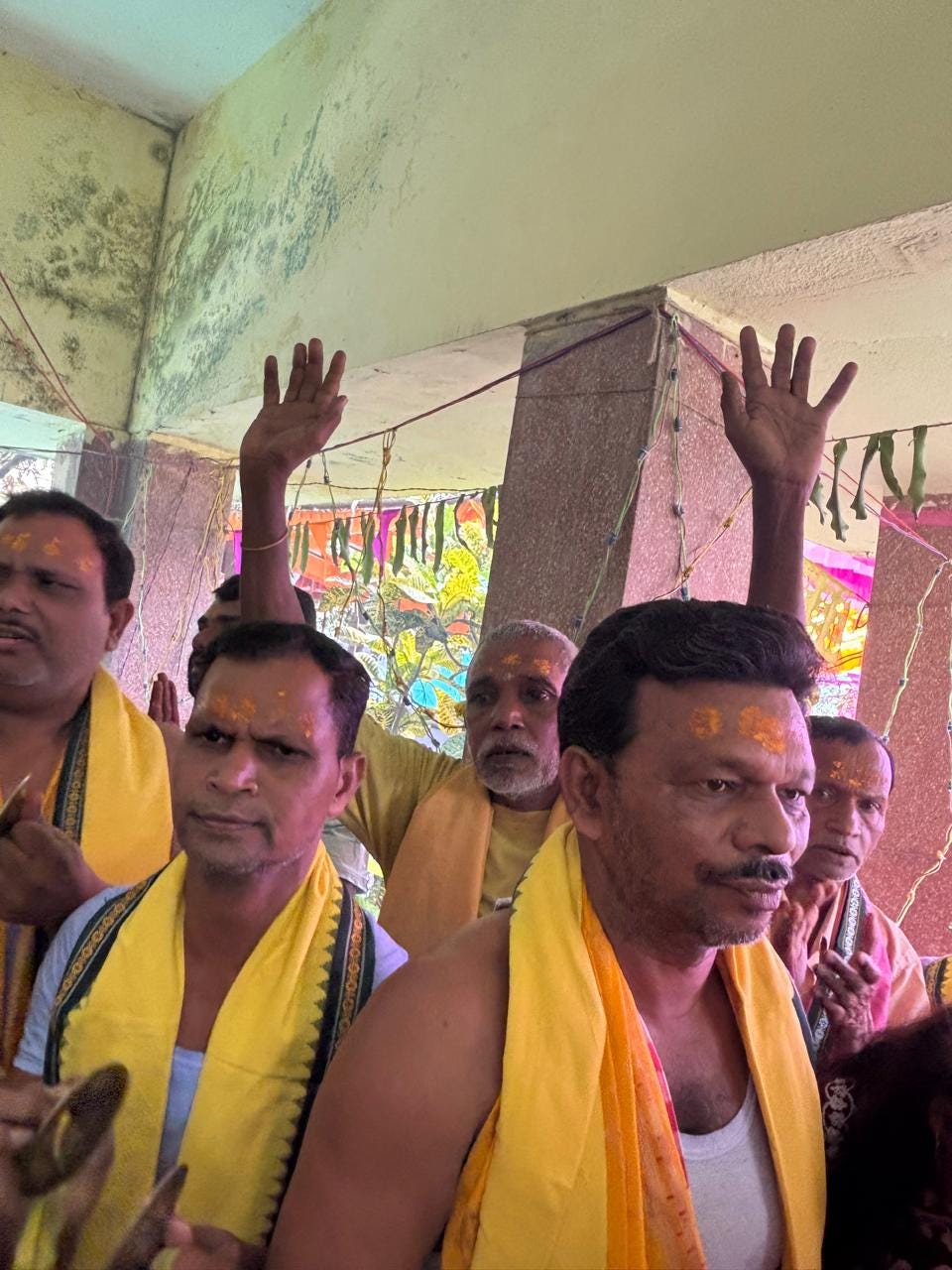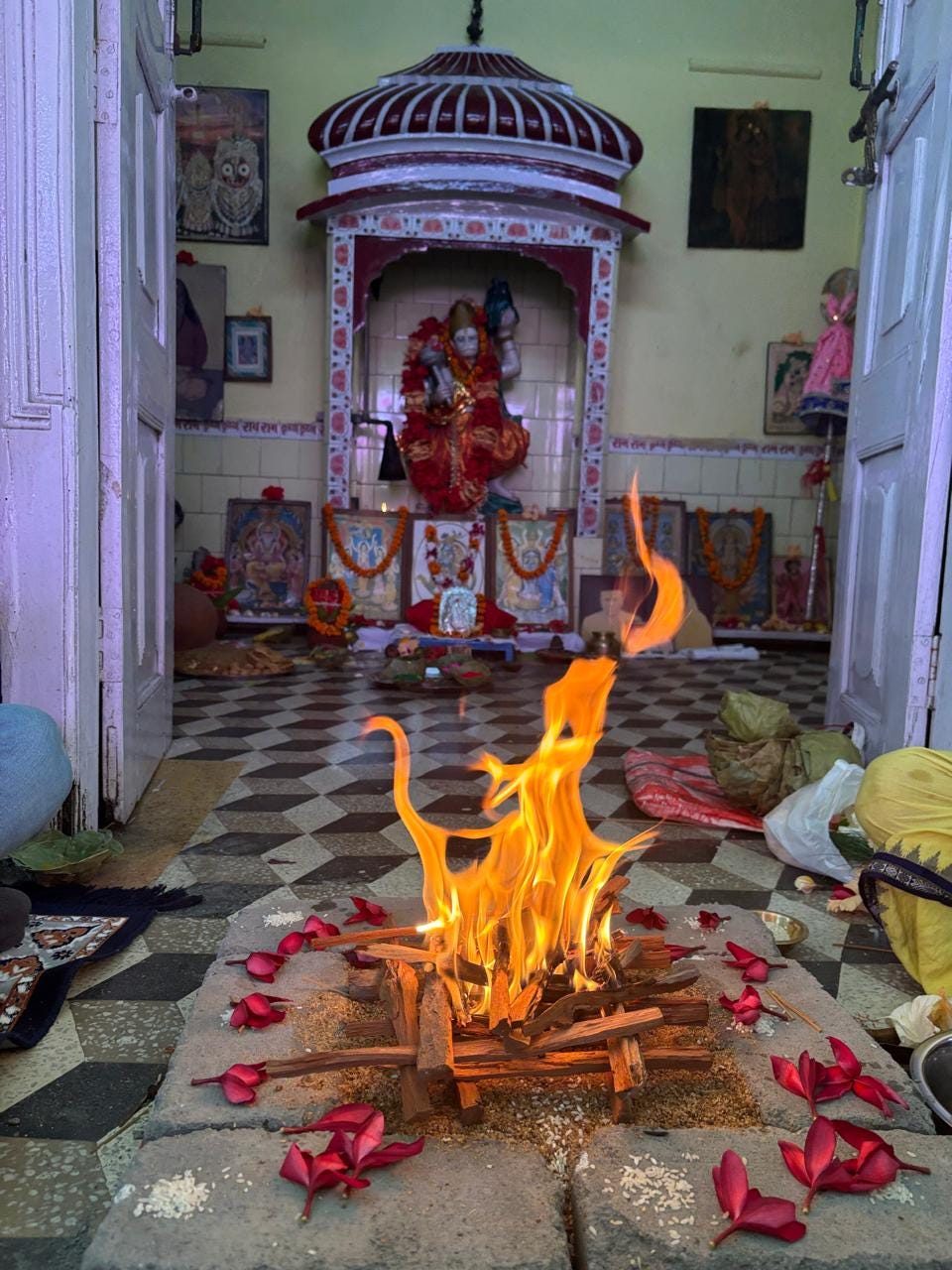It Was a Sacred Noon
The sun poured golden light across the earth, as if blessing everything below—a warm, glowing symbol of abundance. The shamiana stood gracefully, ready to host the dance of devotion. Flowers seemed to silently pop out in anticipation, and the trees around stood still, holding their breath, waiting for the rhythm of surrender to begin.
As I stepped into the temple, the Kirtan had already begun. A host of performers were circling the deity’s sanctum—Lord Hanuman’s sacred chamber—reminding us, once again, that the real journey is always within. 😊
Inside, the air shimmered with sound and silence, devotion and delight. These weren’t mere musicians; they were vessels brimming with divinity.
Some hands were raised in ecstasy.
Some eyes closed, soaking in the vibrations.
Some danced freely, unfazed by heat or dust.
The outer world dissolved.
All that remained was the sacred chant:
Hare Rama Hare Rama, Rama Rama Hare Hare
Hare Krishna Hare Krishna, Krishna Krishna Hare Hare
It wasn’t just a chant.
It was an offering. A letting go. A remembrance.
What Is Kirtan?
Kirtan isn’t just music. It is a sacred spiritual practice—a devotional chanting of mantras that opens the heart and awakens the soul.
Often sung in a call-and-response format, one voice leads, and the rest echo it back until the separation dissolves—and all merge into a collective field of resonance.
Kirtan belongs to the Bhakti Yoga tradition—the yoga of love and devotion. It is the path where love is the method, the message, and the ultimate goal. It’s the soul’s way of reconnecting with the Divine—jivatma returning to paramatma—through pure vibration.
But beyond its philosophy, Kirtan is a felt experience.
It’s not about how well you sing.
It’s about how deeply you feel.
A Legacy of Devotion
Kirtan has ancient roots in the Vedic tradition, where chants invoked divine energies. But it blossomed during the Bhakti Movement, from the 6th century onwards, as saints and mystics across India began to emphasize heart-centered connection with the Divine.
Some names that melt my heart and of many many others - :-)
Sant Kabir, whose dohas pierce through illusion and give you a perspective that takes you straight to the voice of your soul.
Mirabai, who drenched in her love for Krishna made us realise what true love looks like.
Chaitanya Mahaprabhu, who chanted “Hare Rama” with such abandon that entire villages rose in devotion.
Tulsidas, whose shift from worldly desire to an exemplary spiritual surrender showed transformation can happen to anyone who is willing to receive it.
As a child, I woke to the soft echoes of Prabhat Pheri—devotees walking through the streets at dawn, singing “Hare Rama.” I didn’t understand it then, but I felt it. The air vibrated differently.
Now I know: they were tuning the world to the frequency of love.
Why Does Kirtan Feel So Good?
If you've ever been part of a Kirtan, you know: it’s hard to explain but impossible to forget.
You might begin stiff or skeptical, but soon your shoulders drop. Your breath slows. Your voice joins in. Somewhere between the beats, something within you lets go.
That’s not just emotion. That’s energy.
Sound is energy.
Mantras are vibrational codes.
The repetitions transport you to a world beyond the five senses.
Chanting mantras activates your chakras, balances your nervous system, and aligns your heart and brain. You move from the beta brainwave state (stress, analysis) into alpha or theta (calm, creative, meditative).
You don’t need to understand the words.
You just need to be present with the sound.
The vibration does the work.
Kirtan as a Tool for the Inner Journey
For those walking the path of spiritual awakening or energy work, Kirtan supports at many levels:
Quiets the mental noise and brings you into the heart.
Bypasses the ego and connects you to something greater.
Releases buried emotions gently and lovingly.
Creates collective resonance—what you can’t carry alone, the group helps release.
Opens the door to peace, surrender, bliss, and devotion.
So many seekers try to figure things out.
But not everything needs to be understood.
Some things simply need to be sung.
From the Head to the Heart, and Into the Soul
Kirtan doesn’t demand perfection.
It doesn’t care for performance.
It asks for presence.
It invites feeling.
It nurtures being.
In a world obsessed with doing and achieving, Kirtan whispers:
Just be here. Just chant. Just feel.
And you’ll remember who you are.
This is the language of abundance.
Not effort, but allowing.
Not resistance, but surrender.
And Then Came the Homa...
After the Kirtan, the temple shifted into the sacred fire ritual—Homa.
The flames flickered as mantras were offered into the fire. Each “Swaha” felt like a release—a fear, a doubt, an old identity falling away. The fire transformed the subtle into the sacred.
Then came celebration.
We smeared colors on each other—not just on faces, but across the rigid walls of the inner self. The Dahi Matki—symbolically smashing the shell that hides our sweetness.
What remained?
✨ Laughter.
✨ Lightness.
✨ Love.
An open heart and a silent mind.
Cross over the bridge...
Whether you’re just beginning your journey or have walked this path for decades, let Kirtan be a companion.
It doesn’t need to be loud. Or long.
Even one mantra, repeated with love, becomes a bridge—from the fragmented self to the sacred whole.
So next time you feel anxious, scattered, or disconnected…
Don’t scroll.
Don’t run.
Just sit.
Close your eyes.
And chant:
Hare Rama Hare Rama, Rama Rama Hare Hare
Hare Krishna Hare Krishna, Krishna Krishna Hare Hare
Let the sound carry you home.
Let the soul remember the song it came here to sing. 🌺
✨ May your voice rise in devotion. May your heart soften into stillness. May your soul remember its song. ✨






